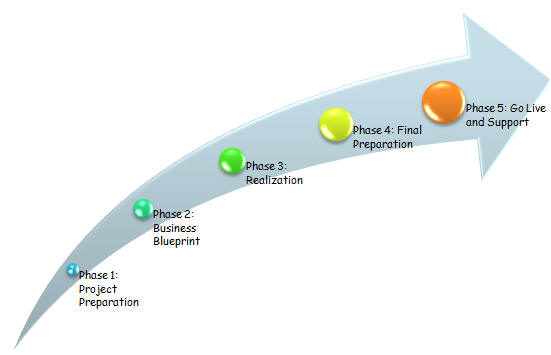|

| |
 Méthodologie Universelle pour SAP: Méthodologie Universelle pour SAP:
The ASAP Roadmap is a detailed project plan by SAP that describes all activities
in an implementation. It includes the entire technical area to support technical
project management and addresses things like interfaces, data conversions and
authorizations earlier than in most traditional implementations.

The ASAP Roadmap consists of five phases: Project Preparation, Business
Blueprint, Realization, Final Preparation, Go live and support continuous
change.
ASAP provides examples, checklists, or templates as samples for e.g. a cutover
plan. They are used as a starting point to avoid "reinventing the wheel". ASAP
calls these things Accelerators.

Phase 1 - Project Preparation
Proper planning and assessing organizational readiness is essential. Determine
if there is :
- full agreement that all company decision makers are behind the project.
- clear project objectives
- an efficient decision-making process
- a company culture that is willing to accept change
Accelerated SAP's Project Estimator can be used to guide the project team
through a series of predefined questions, and drives interviews with senior
executives and key operating managers about their expectations of R/3 and the
speed of its deployment.
Phase 2 - Business Blueprint
The Engineer delivers a complete toolkit of predefined business processes.
During the Business Blueprint phase R/3's broad scope is narrowed to fit the
industry-specific processes. Using questionnaires and the models from the
Business Engineer, the business processes are documented to reflect the future
vision of the business. Industry templates further accelerate the process by
predefining industry best business practices. The result is a comprehensive
blueprint of the business. During this phase training begins on R/3's integrated
business systems. Level 2 hands-on training provides a step-by-step education of
R/3 business process skills. The Business Blueprint is a visual model of your
business' future state It will allow the project team to clearly define the
scope, and only focus on the R/3 processes needed to run the business.
Phase 3 - Realization
Based on the Business Blueprint, a two-step process is began of configuring the
R/3 system. First the baseline system will be configured. Second the system is
fine tuned to meet all of the business process requirements. Because the initial
configuration is based on the blueprint, the baseline system gives a real-world
view of how the business transactions will actually run.
Phase 4 - Final Preparation
In this phase, the R/3 system is fine-tuned. Necessary adjustments are made in
order to prepare the system and the business for production start-up. Final
systems tests are conducted and end-user training is completed. Initial audit
procedures are developed.
Phase
5 - Go Live and Support
In this phase, procedures and measurements are developed to review the benefits
of the R/3 investment on an ongoing basis. SAP support and services are provided
to ensure that the system continues to run smoothly. The Online Service System
(OSS) provides electronic support using a remote connection. The Implementation
Assistant provides answers for most questions that may arise. it is an
easy-to-use repository of information defining what to do, who should do it, and
how long it should take.
|

![[Under Construction]](images/undercon.gif)

![[Under Construction]](images/undercon.gif)